WILD LIFE | Gentrificide
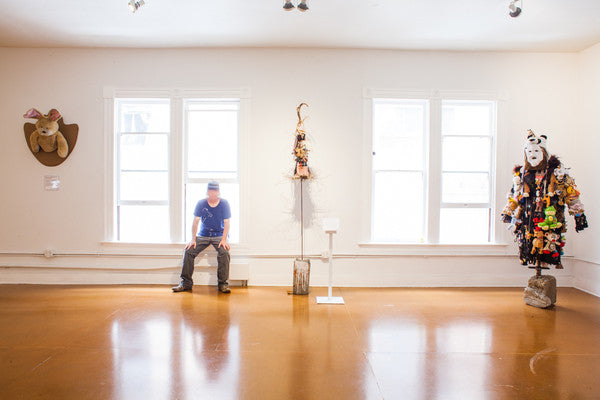
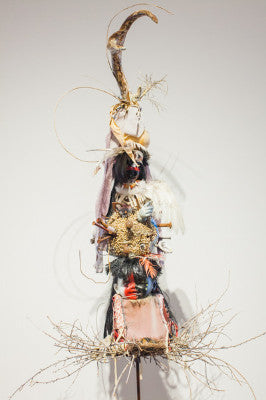
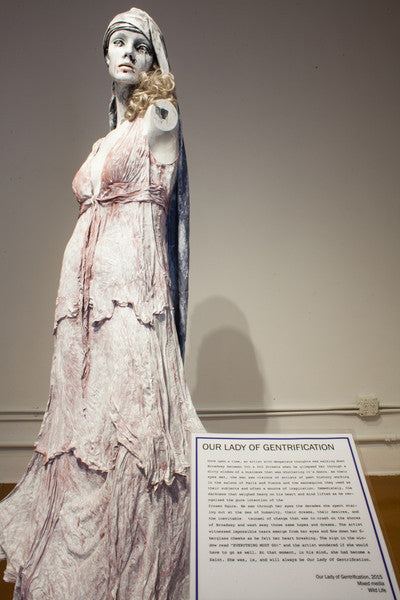
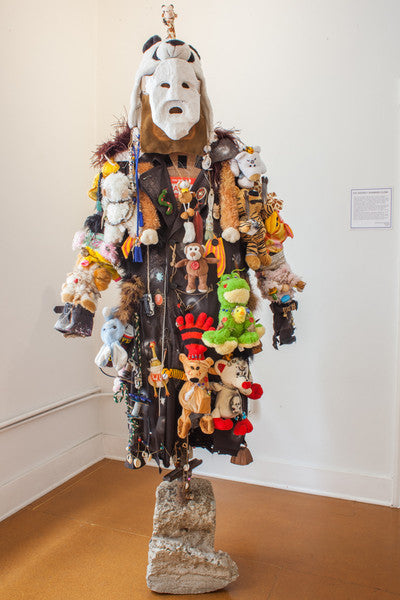
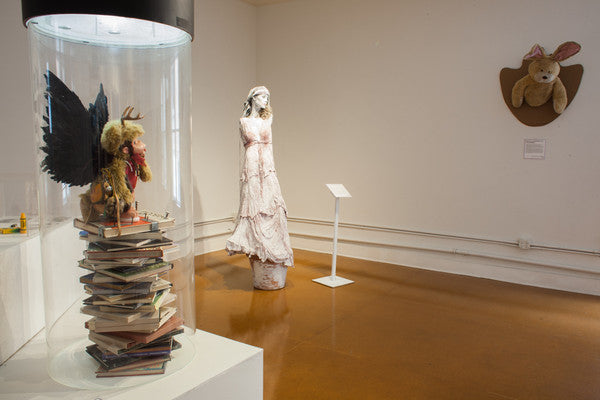
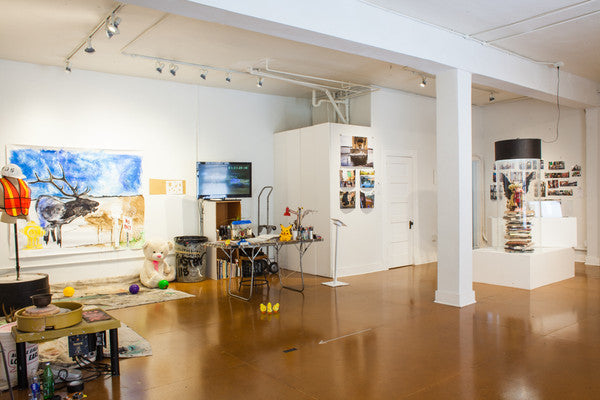
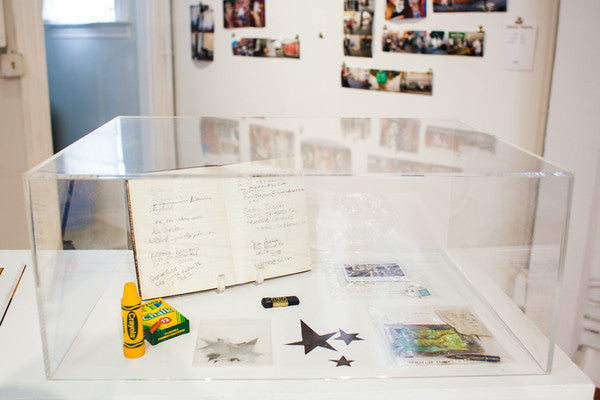
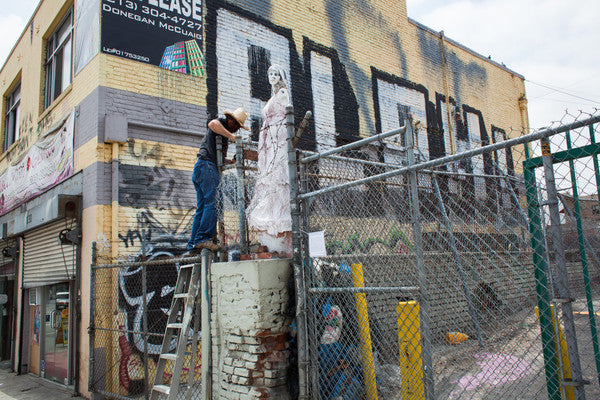
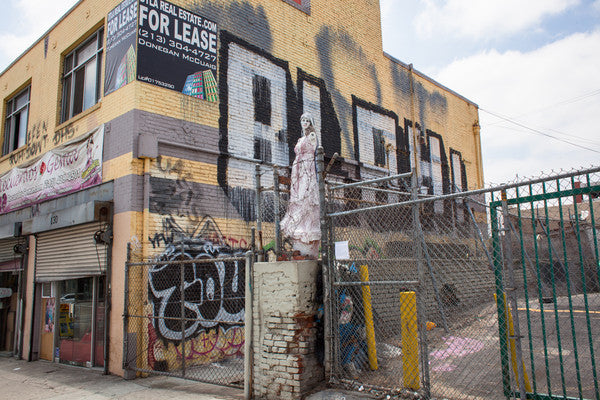



This experimental installation by Los Angeles-based street artist and cult figure Wild Life recreates a functioning artist studio in the gallery. From this base of operations he constructs assemblages originating out of mythologies of his own making. While technically a residency and not an exhibit, the collection of work garnered the title Gentrificide after his project began to take shape. The artist created placards for each piece recounting the myth that inspired each work. With titles such as “Our Lady of Gentrification”, “Totem of the Lost Tribe of Skid Row”, “Road Kill as a Byproduct of Development” and “The Toy District Shaman’s Cloak”, the result was a disturbing yet humorous commentary on the rapidly changing landscape of downtown Los Angeles.
THE MYTH OF WILD LIFE
In 2012 eight official looking plaques were installed in unusual locations around the city of Los Angeles. These placards referred to particular sites as cultural landmarks through forged signatures by Mayor Antonio Villaraigosa and former Museum of Contemporary Art director Jeffrey Deitch. The fake attractions brought attention to everyday aspects of design that seemingly go unnoticed on our daily commutes. The elusive and mysterious artist behind these installations refers to himself as Wild Life. An artist who has a long history of outdoor installations that shake the lenses we use each day to understand the world.
Wild Life’s art varies from DIY paper mache animals to painstakingly accurate designs that are incorporated within existing aspects of the city. Part shaman and showman – the artist carefully documents his artistic process that often is ephemeral and ever changing. The pseudonym Wild Life is conceptually and descriptively appropriate for this engaging artist. He’s a romantic with high ideals who is not afraid to make a bold statement. Based upon his oeuvre and ongoing visual process it’s apparent he craves the natural over the industrial.
Yet this counter culture artist that is difficult to pin down has agreed to an artist residency at These Days Gallery. The result is a living installation that is in constant motion. More than simulating an artist studio, Wild Life has made the gallery his home base complete with a workstation as he assembles an untamed series of pieces that are in a state of evolution. For the length of his residency he is not keeping set hours and instead comes and goes as he pleases, bringing in objects that are added to the pieces on display. The product and the performance are equally important aspects of Wild Life’s work, a condition that makes the installation story just as entertaining and interesting as the final product.
The gallery exhibition is haunting at first glance. Specifically the mixed media piece Our Lady of Gentrification, a ghostly figure that floats above a large plastic flowerpot centrally placed in the gallery. Wild Life tells the story of an artist walking in downtown Los Angeles who peeks inside the dirty window of a storefront to see a mannequin for sale. The artist had visions of the salons of the past as he stared longingly at the frozen figure. The artist was able to see through her eyes as years of change swept through the neighborhood. The armless figure was unable to change anything despite her bold posture. The sculpture is loaded with religious symbolism and the final aesthetic makes her somewhat uncomfortable to be around despite the loving history.
Another object entitled the Toy District Shamans Cloak continues Wild Life’s play on ritual and imagined histories. An out of work shaman bequeathed his cloak to Wild Life on his deathbed and it now is adorned with furry stuffed animals in the gallery space. Shamans interact with the spirit world and practice different types of healing. The new cloak named after the industrial section of Los Angeles that houses several inexpensive retail novelty stores appears ready to heal the struggling industry as apartments sprawl outwards into this territory. A cloak should be worn and it’s implied that Wild Life has now taken on the Shaman role through his artistic process. A role that seems appropriate considering the artist’s eye toward tradition, mystery, and history.
It’s apparent from Wild Life’s history of performance and engaging installations that he is a mythmaker and contemporary soothsayer. These are not simple tricks. Instead his art is a vehicle that brings attention to issues like gentrification, the loss of culture in our everyday lives, and the power of art to awaken our senses. The 2012 dumpster with the placard was not designed by Andy Warhol but the idea that we might value it more because of this sign raises questions about how we place value on objects. Wild Life’s art is a significant contribution for a society that quickly forgets the role of visual knowledge and how it impacts the way we engage the overabundance of aesthetic culture.
- James Daichendt serves as Professor and Dean of Arts and Humanities at Point Loma Nazarene University in southern California. He is author of the books Shepard Fairey Inc. Artist/Professional/Vandal, Stay Up! Los Angeles Street Art, and the forthcoming text Kenny Scharf: In Absence of Myth.
